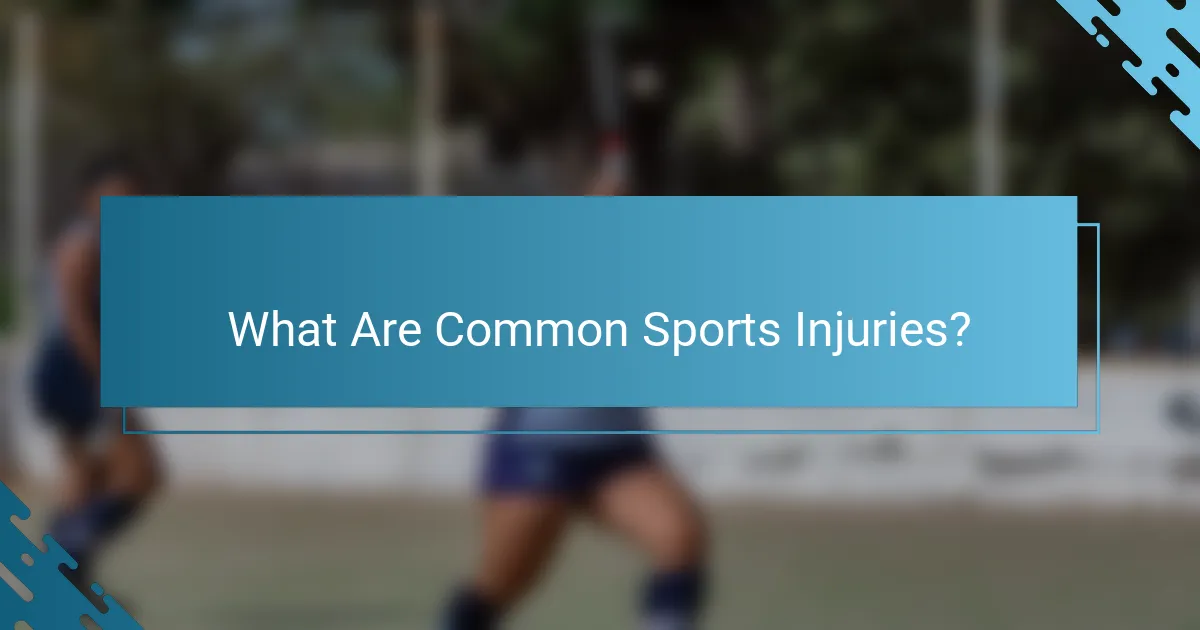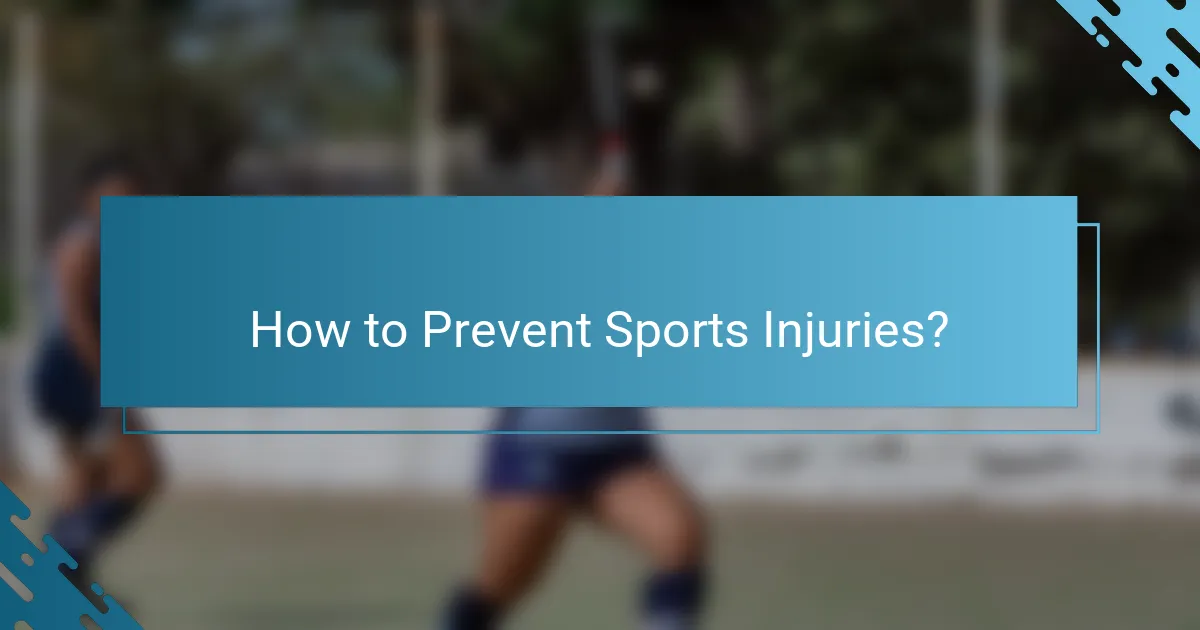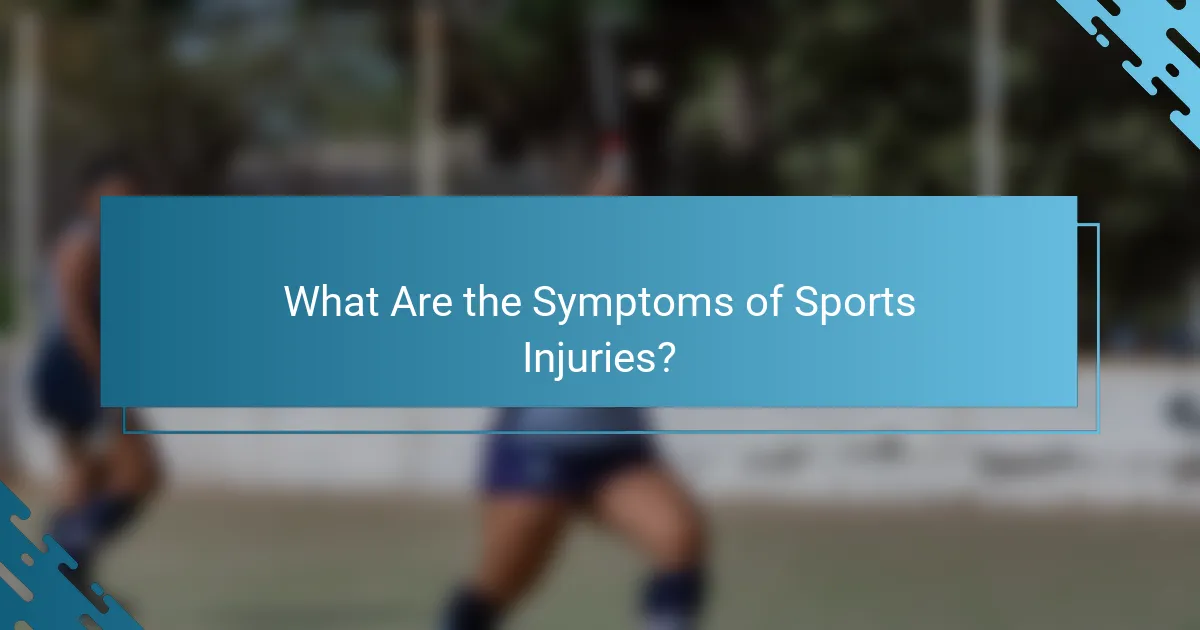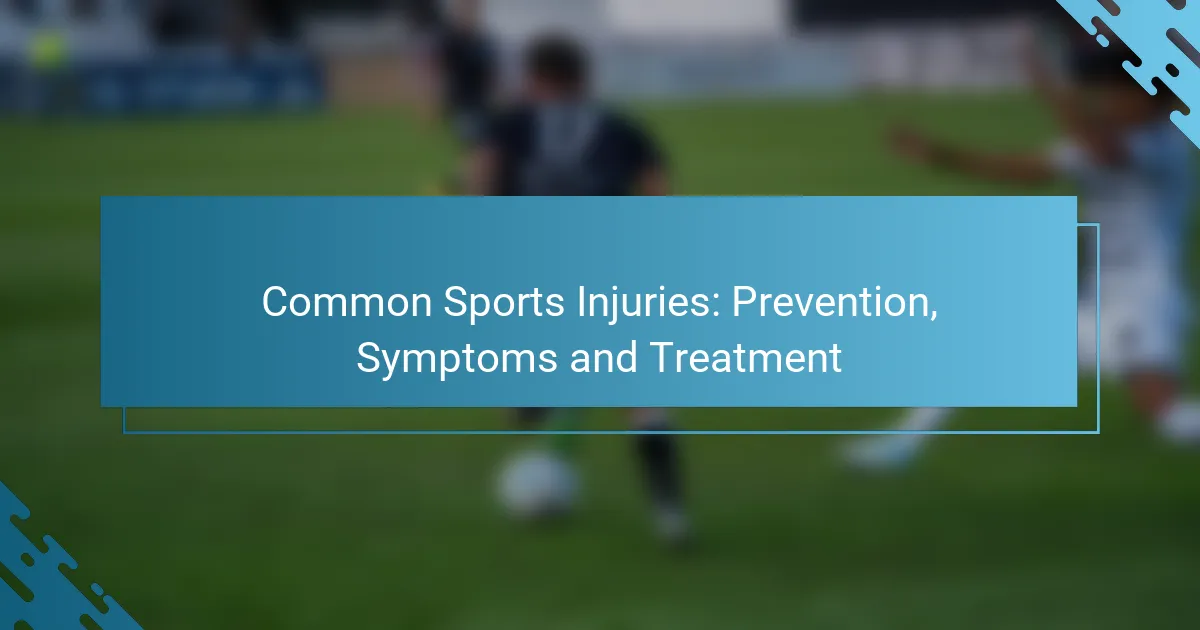Sports injuries are common among athletes and can affect different areas of the body, often resulting from overexertion, poor technique, or accidents. Understanding how to prevent these injuries through proper techniques, protective gear, and lifestyle choices is essential for maintaining athletic performance. Early recognition of symptoms can lead to timely treatment and a quicker recovery, ensuring athletes can return to their activities safely.

What Are Common Sports Injuries?
Common sports injuries include a range of physical ailments that athletes may encounter during activities. These injuries can affect various parts of the body and often result from overexertion, improper technique, or accidents.
Sprains
Sprains occur when ligaments, the tissues connecting bones at a joint, are stretched or torn. They commonly affect areas like the ankle, knee, and wrist. Symptoms typically include pain, swelling, and limited mobility.
To prevent sprains, athletes should warm up properly, use appropriate footwear, and practice good technique. If a sprain occurs, rest, ice, compression, and elevation (RICE) are effective initial treatment steps.
Strains
Strains involve the stretching or tearing of muscles or tendons, which connect muscles to bones. Common sites for strains include the hamstrings, quadriceps, and lower back. Symptoms often include muscle spasms, weakness, and swelling.
Preventing strains can be achieved through regular strength training and flexibility exercises. In case of a strain, applying RICE and consulting a healthcare professional for severe cases is advisable.
Fractures
Fractures are breaks in bones that can occur due to high-impact collisions or falls. They can range from hairline fractures to complete breaks and are often accompanied by intense pain, swelling, and deformity in the affected area.
To minimize the risk of fractures, athletes should wear protective gear and avoid risky maneuvers. Treatment usually involves immobilization with a cast or splint, and in some cases, surgery may be required.
Concussions
Concussions are traumatic brain injuries caused by a blow to the head or body that shakes the brain. Symptoms can include confusion, headaches, dizziness, and memory issues. Immediate assessment is crucial for proper management.
Preventing concussions involves using appropriate headgear and following safety protocols in sports. If a concussion is suspected, it is essential to seek medical attention and follow a gradual return-to-play protocol.
Tendinitis
Tendinitis is the inflammation of tendons, often resulting from repetitive motion or overuse. Commonly affected areas include the elbow (tennis elbow), shoulder, and knee (jumper’s knee). Symptoms typically involve pain and tenderness near a joint.
To prevent tendinitis, athletes should incorporate rest periods and cross-training into their routines. Treatment may include rest, ice, anti-inflammatory medications, and physical therapy to strengthen the affected area.

How to Prevent Sports Injuries?
Preventing sports injuries involves a combination of proper techniques, protective measures, and lifestyle choices. By focusing on warm-ups, using appropriate gear, engaging in strength training, and staying hydrated, athletes can significantly reduce their risk of injury.
Proper Warm-up Techniques
Effective warm-up techniques prepare the body for physical activity and help prevent injuries. A good warm-up should include dynamic stretches and movements that mimic the sport being played, lasting around 10-15 minutes.
Examples of warm-up exercises include leg swings, arm circles, and light jogging. These activities increase blood flow to the muscles and improve flexibility, making the body more resilient to stress during competition.
Use of Protective Gear
Wearing appropriate protective gear is crucial for injury prevention in sports. Items such as helmets, knee pads, and mouthguards can significantly reduce the risk of serious injuries.
It’s important to choose gear that meets safety standards relevant to the sport. For instance, football helmets should comply with the National Operating Committee on Standards for Athletic Equipment (NOCSAE) regulations to ensure maximum protection.
Strength Training
Incorporating strength training into a regular fitness routine enhances muscle strength and stability, which can help prevent injuries. Focus on exercises that target key muscle groups used in your sport, aiming for at least two sessions per week.
Examples include squats, lunges, and core exercises. Gradually increasing weights and resistance can build strength effectively while minimizing the risk of overexertion.
Adequate Hydration
Staying adequately hydrated is essential for maintaining performance and preventing injuries. Dehydration can lead to muscle cramps, fatigue, and decreased coordination, increasing the likelihood of accidents.
Athletes should aim to drink water before, during, and after exercise, adjusting their intake based on the intensity and duration of the activity. A general guideline is to consume about 500-700 ml of water in the hours leading up to a workout and to drink regularly during physical activity.

What Are the Symptoms of Sports Injuries?
Sports injuries can manifest through various symptoms, which may indicate the type and severity of the injury. Recognizing these symptoms early can facilitate timely treatment and recovery.
Pain and Discomfort
Pain is often the most immediate and noticeable symptom of a sports injury. It can range from mild discomfort to severe pain, depending on the injury’s nature and extent. Athletes should pay attention to any persistent or worsening pain during physical activity.
Common types of pain include sharp pain during movement, dull aches at rest, or localized tenderness. If pain persists beyond a few days or is accompanied by other symptoms, seeking medical advice is advisable.
Swelling and Inflammation
Swelling is a typical response to injury, indicating inflammation in the affected area. It can occur rapidly after an injury and may be accompanied by warmth and redness. Swelling can limit mobility and functionality, making it essential to address it promptly.
Applying ice and elevating the injured area can help reduce swelling. If swelling does not subside within a few days or worsens, it may signal a more serious injury that requires medical evaluation.
Limited Range of Motion
A reduced range of motion is often a direct consequence of pain and swelling. Athletes may find it difficult to move the affected joint or muscle fully, which can hinder performance and daily activities. This limitation can be temporary or indicate a more severe injury.
Gentle stretching and rehabilitation exercises can help restore mobility. However, if significant restrictions persist, a healthcare professional should assess the injury to determine the appropriate treatment plan.
Bruising
Bruising, or contusions, occurs when small blood vessels break under the skin, leading to discoloration. This symptom often accompanies other signs of injury, such as pain and swelling. The severity of bruising can vary, indicating the extent of the underlying damage.
While minor bruises typically heal on their own, severe bruising may require medical attention, especially if it is associated with significant pain or swelling. Monitoring the bruise for changes in size or color can help assess healing progress.

How to Treat Sports Injuries?
Treating sports injuries effectively involves a combination of immediate care and ongoing rehabilitation. Key methods include rest, ice application, compression, physical therapy, and pain relief medication.
Rest and Recovery
Rest is crucial for healing any sports injury. It allows the body to repair damaged tissues and reduces the risk of further injury. Depending on the severity, rest may range from a few days to several weeks.
During recovery, avoid activities that exacerbate the injury. Gradually reintroduce movement as healing progresses, ensuring to listen to your body’s signals to prevent setbacks.
Ice and Compression
Applying ice to the injured area can significantly reduce swelling and numb pain. Use ice packs for about 15-20 minutes every hour during the first 48 hours post-injury.
Compression with an elastic bandage can help manage swelling. Ensure the bandage is snug but not so tight that it restricts blood flow. Remove it periodically to allow circulation.
Physical Therapy
Physical therapy is often essential for restoring strength and flexibility after a sports injury. A trained therapist can design a personalized rehabilitation program tailored to your specific injury and activity level.
Therapy may include exercises to improve range of motion, strength training, and techniques to prevent future injuries. Consistent attendance and adherence to the program are key for effective recovery.
Medication for Pain Relief
Over-the-counter medications, such as ibuprofen or acetaminophen, can help manage pain and inflammation associated with sports injuries. Always follow the recommended dosages and consult a healthcare provider if pain persists.
In some cases, a doctor may prescribe stronger pain relief or anti-inflammatory medications. Be aware of potential side effects and interactions with other medications you may be taking.

When to Seek Medical Attention?
Seek medical attention if you experience significant discomfort or if symptoms persist beyond a few days. Early intervention can prevent further injury and facilitate a quicker recovery.
Severe Pain
Severe pain during or after physical activity is a clear signal that something may be wrong. If the pain is sharp, intense, or debilitating, it is crucial to consult a healthcare professional as soon as possible.
Consider the location of the pain; for instance, joint pain could indicate a sprain or fracture, while muscle pain might suggest a strain. Ignoring severe pain can lead to complications and prolonged recovery times.
Persistent Symptoms
Persistent symptoms, such as swelling, bruising, or limited mobility lasting more than a few days, warrant medical evaluation. These signs can indicate underlying issues that need to be addressed to avoid long-term damage.
If you notice symptoms like chronic stiffness or recurring discomfort, it’s advisable to seek a professional opinion. Early diagnosis and treatment can significantly improve outcomes and help you return to your sport safely.
